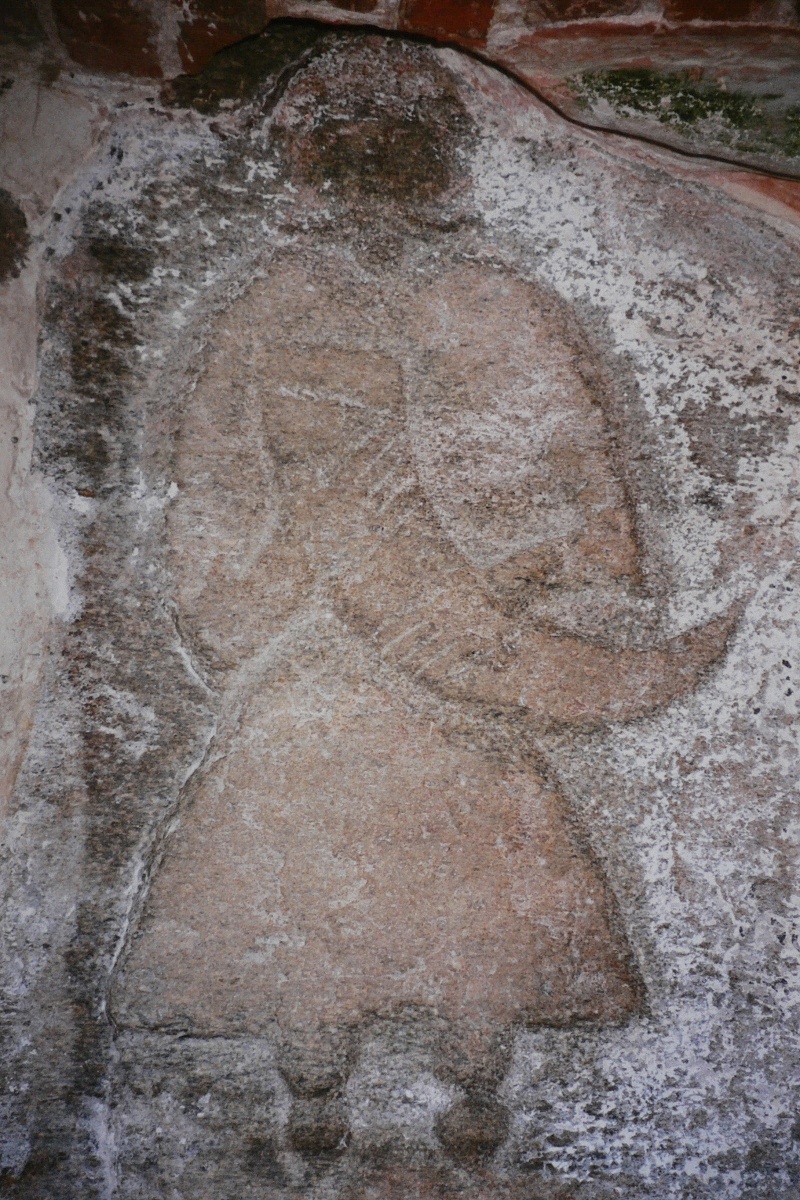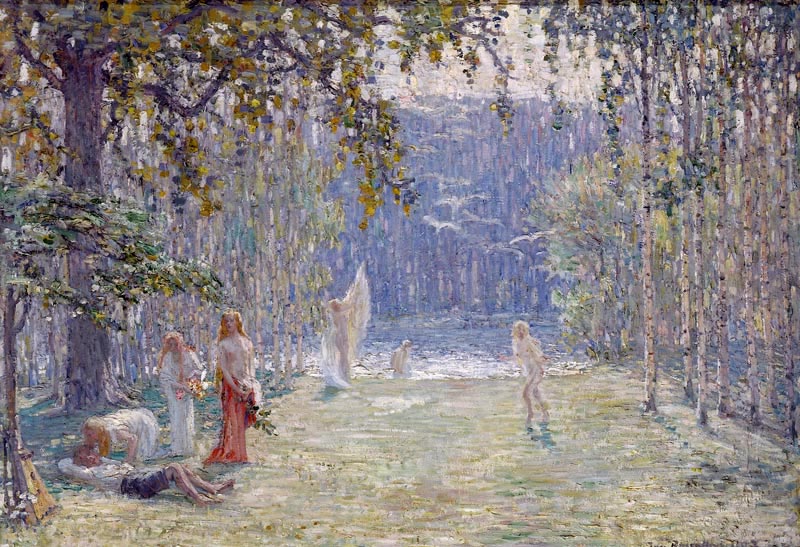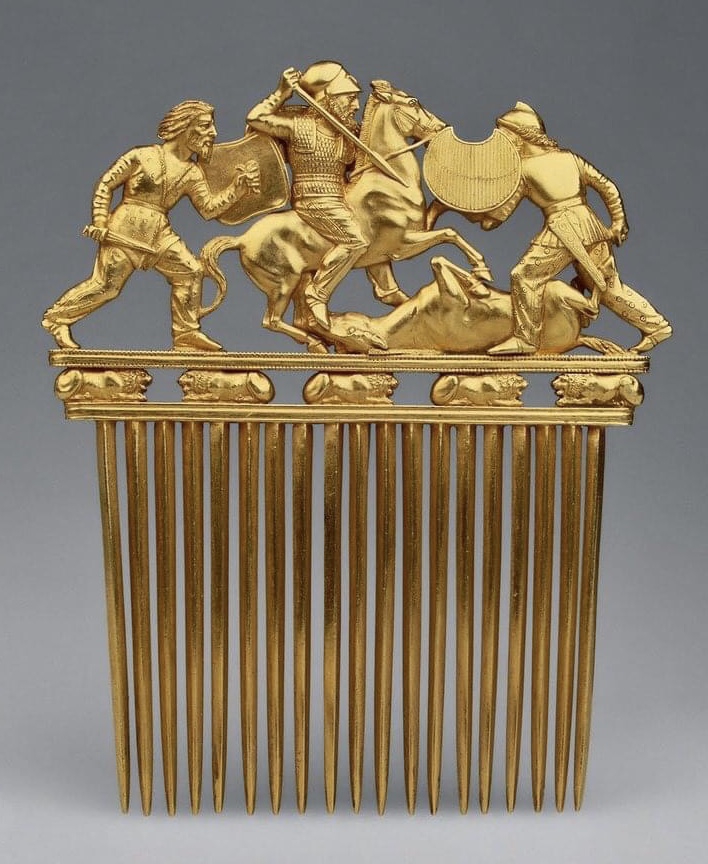|
Percunatele
Perkunatete, Perkunatele or Perkūnėlė is in Baltic mythology the thunder goddess mother of Perkūnas, in Slavic mythology referred to as Percunatele mother of Perun, which is probably derived from the Balts. Like many such goddesses absorbed into Christianity, she is, today, difficult to distinguish from the Christian madonna, Mary, one of whose epithets was Panna Maria Percunatele. Professor Patricia Monaghan of DePaul University also believes that she was originally derived from the Baltic thunder goddess. The character of Perkunatete seems to be present in the myths of Baltic sun goddess Saulė. This solar goddess, after her daily ride, bathes in a sauna to rest and recover her strength for another daily travel, with Perkunatete waiting on her. In the book of Georges Dumézil, it is described that Perkunatele was represented as an oak tree with a cleft, resembling the female genitals, where lightning hit. A fire could sometimes break out when the wood was not humid, bringin ... [...More Info...] [...Related Items...] OR: [Wikipedia] [Google] [Baidu] |
Perkūnas
Perkūnas (, , Old Prussian: ''Perkūns'', ''Perkunos'', Sudovian language, Yotvingian: ''Parkuns'', Latgalian language, Latgalian: ''Pārkiuņs'') was the common Baltic languages, Baltic List of thunder gods, god of thunder, and the second most important deity in the Baltic Pantheon (gods), pantheon after Dievas. In both Lithuanian mythology, Lithuanian and Latvian mythology, he is documented as the god of sky, thunder, lightning, storms, rain, fire, war, law, order, fertility, mountains, and oak trees. Etymology The name continues PIE ''*'', cognate to ''*'', a word for "oak", "fir" or "wooded mountain". The Proto-Baltic language, Proto-Baltic name *''Perkūnas'' can be reconstructed with certainty. Slavic Perun is a related god, but not an etymologically precise match. Finnish people, Finnish Perkele, a name of Ukko, is considered a loan from Baltic. Another connection is that of ''terpikeraunos'', an epithet of Zeus meaning "''who enjoys lightning''". Perkūnas in wri ... [...More Info...] [...Related Items...] OR: [Wikipedia] [Google] [Baidu] |
Baltic Mythology
Baltic mythology is the body of mythology of the Baltic peoples stemming from Baltic paganism and continuing after Christianization and into Baltic folklore. History Baltic mythology ultimately stems from Proto-Indo-European mythology. The Baltic region was one of the last regions of Europe to be Christianized, a process that began in the 15th century and continued for at least a century afterward. While no native texts survive detailing the mythology of the Baltic peoples during the pagan period, knowledge of such beliefs may be gained from Roman and German chronicles, from later folklore, from etymology and from the reconstructions of comparative mythology.Puhvel (1989:222-229). While the early chronicles (14th and 15th century) were largely the product of missionaries who sought to eradicate the native paganism of the Baltic peoples, rich material survives into Baltic folklore. This material has been of particular value in Indo-European studies as, like the Baltic languages ... [...More Info...] [...Related Items...] OR: [Wikipedia] [Google] [Baidu] |
Slavic Mythology
Slavic paganism, Slavic mythology, or Slavic religion refer to the Religion, religious beliefs, myths, and ritual practices of the Slavs before Christianisation of the Slavs, Christianisation, which occurred at various stages between the 8th and the 13th century. The South Slavs, who likely settled in the Balkans during the 6th–7th centuries AD, bordering with the Byzantine Empire to the south, came under the sphere of influence of Eastern Christianity relatively early, beginning with the creation of writing systems for Slavic languages (first Glagolitic, and then Cyrillic script) in 855 by the brothers Saints Cyril and Methodius and the adoption of Christianity in First Bulgarian Empire, Bulgaria in 864 and 863 in Great Moravia. The East Slavs followed with the official adoption in 988 by Vladimir the Great of Kievan Rus'. The process of Christianising the West Slavs was more gradual and complicated compared to their eastern counterparts. The Moravians accepted Christianity a ... [...More Info...] [...Related Items...] OR: [Wikipedia] [Google] [Baidu] |
Perun
In Slavic paganism, Slavic mythology, Perun () is the highest god of the Pantheon (religion), pantheon and the god of sky, thunder, lightning, storms, rain, law, war, fertility and oak trees. His other attributes were fire, mountains, wind, iris (plant), iris, eagle, firmament (in Indo-European languages, this was joined with the notion of the ''sky of stone''), horses and carts, and weapons (hammer, axe (Axe of Perun), and arrow). The supreme god in the Kievan Rus' during the 9th-10th centuries, Perun was first associated with weapons made of Rock (geology), stone and later with those of metal. Sources Of all historic records describing Slavic gods, those mentioning Perun are the most numerous. As early as the 6th century, he was mentioned in ''De Bello Gothico'', a historical source written by the Byzantine Empire, Eastern Roman historian Procopius. A short note describing beliefs of a certain South Slavic tribe states they ''acknowledge that one god, creator of lightning, ... [...More Info...] [...Related Items...] OR: [Wikipedia] [Google] [Baidu] |
Mary (mother Of Jesus)
Mary was a first-century Jewish woman of Nazareth, the wife of Joseph and the mother of Jesus. She is an important figure of Christianity, venerated under various titles such as virgin or queen, many of them mentioned in the Litany of Loreto. The Eastern and Oriental Orthodox, Catholic, Anglican, Methodist, Reformed, Baptist, and Lutheran churches believe that Mary, as mother of Jesus, is the Mother of God. The Church of the East historically regarded her as Christotokos, a term still used in Assyrian Church of the East liturgy. Other Protestant views on Mary vary, with some holding her to have lesser status. She has the highest position in Islam among all women and is mentioned numerous times in the Quran, including in a chapter named after her.Jestice, Phyllis G. ''Holy people of the world: a cross-cultural encyclopedia, Volume 3''. 2004, , p558 Sayyidana Maryam . She is also revered in the Baháʼí Faith and the Druze Faith. The synoptic Gospels name Mary as the ... [...More Info...] [...Related Items...] OR: [Wikipedia] [Google] [Baidu] |
Epithet
An epithet (, ), also a byname, is a descriptive term (word or phrase) commonly accompanying or occurring in place of the name of a real or fictitious person, place, or thing. It is usually literally descriptive, as in Alfred the Great, Suleiman the Magnificent, Richard the Lionheart, and Ladislaus the Short, or allusive, as in Edward the Confessor, William the Conqueror, Æthelred the Unready, John Lackland, Mehmed the Conqueror and Bloody Mary. The word ''epithet'' also may refer to an abusive, defamatory, or derogatory word or phrase. This use is criticized by Martin Manser and other proponents of linguistic prescription. H. W. Fowler noted in 1926 that "''epithet'' is suffering a vulgarization that is giving it an abusive imputation." Linguistics Epithets are sometimes attached to a person's name or appear in place of their name, as what might be described as a glorified nickname or sobriquet, and for this reason some linguists have argued that they should be c ... [...More Info...] [...Related Items...] OR: [Wikipedia] [Google] [Baidu] |
Patricia Monaghan
Patricia Monaghan (February 15, 1946, – November 11, 2012) was a poet, a writer, a spiritual activist, and an influential figure in the contemporary women's spirituality movement. Monaghan wrote over 20 books on a range of topics including Goddess spirituality, earth spirituality, Celtic mythology, the landscape of Ireland, and techniques of meditation. In 1979, she published the first encyclopedia of female divinities, a book which has remained steadily in print since then and was republished in 2009 in a two volume set as ''The Encyclopedia of Goddesses and Heroines''. She was a mentor to many scholars and writers including biologist Cristina Eisenberg, poet Annie Finch, theologian Charlene Spretnak, and anthropologist Dawn Work-MaKinne, and was the founding member of the Association for the Study of Women and Mythology, which brought together artists, scholars, and researchers of women-centered mythology and Goddess spirituality for the first time in a national academic or ... [...More Info...] [...Related Items...] OR: [Wikipedia] [Google] [Baidu] |
DePaul University
DePaul University is a private university, private Catholic higher education, Catholic research university in Chicago, Illinois, United States. Founded by the Congregation of the Mission, Vincentians in 1898, the university takes its name from the 17th-century French priest Vincent de Paul, Saint Vincent de Paul. In 1998, it became the largest Catholic theology, Catholic university in terms of enrollment in North America. Following in the footsteps of its founders, DePaul places special emphasis on recruiting first-generation students and others from disadvantaged backgrounds. DePaul's two campuses are located in Lincoln Park, Chicago, Lincoln Park and the Chicago Loop, Loop. DePaul is Carnegie Classification of Institutions of Higher Education, classified among "R2: Doctoral Universities – High research activity". The university enrolls around 14,500 undergraduates and about 7,900 graduate/law students. In 2017, about 90% of DePaul's students commuted or lived off campus. Th ... [...More Info...] [...Related Items...] OR: [Wikipedia] [Google] [Baidu] |
Saulė
Saulė (, ) is a solar goddess, the common Baltic solar deity in the Lithuanian and Latvian mythologies. The noun ''Saulė''/''Saule'' in the Lithuanian and Latvian languages is also the conventional name for the Sun and originates from the Proto-Baltic name *''Sauliā'' > *''Saulē''. Representation Saulė is one of the most powerful deities, the goddess of the sun itself, responsible for all life on Earth. She is the patroness of the unfortunate, especially orphans. The Lithuanian and Latvian words for "the world" (''pasaulis'' and ''pasaule'') are translated as " placeunder the Sun". Saulė is mentioned in one of the earliest written sources on Lithuanian mythology. According to the Slavic translation of the Chronicle by John Malalas (1261), a smith named Teliavelis made the Sun and threw it into the sky. Missionary Jerome of Prague (ca. 1369–1440) spent three years attempting to Christianize Lithuania and later recounted a myth about the kidnapped Saulė. She was h ... [...More Info...] [...Related Items...] OR: [Wikipedia] [Google] [Baidu] |
Georges Dumézil
Georges Edmond Raoul Dumézil (4 March 189811 October 1986) was a French Philology, philologist, Linguistics, linguist, and religious studies scholar who specialized in comparative linguistics and comparative mythology, mythology. He was a professor at Istanbul University, École pratique des hautes études and the Collège de France, and a member of the Académie Française. Dumézil is well known for his formulation of the trifunctional hypothesis on Proto-Indo-European mythology and Proto-Indo-European society, society. His research has had a major influence on the fields of comparative mythology and Indo-European studies. In the 1930s he was a supporter (though not a formal member) of the far-right group Action Française, leading to criticism from left-wing scholars in the 1980s and afterwards. Early life and education Georges Dumézil was born in Paris, France, on 4 March 1898, the son of :fr:Jean Dumézil, Jean Anatole Jean Dumézil and Marguerite Dutier. His father was a ... [...More Info...] [...Related Items...] OR: [Wikipedia] [Google] [Baidu] |
Cognate
In historical linguistics, cognates or lexical cognates are sets of words that have been inherited in direct descent from an etymological ancestor in a common parent language. Because language change can have radical effects on both the sound and the meaning of a word, cognates may not be obvious, and it often takes rigorous study of historical sources and the application of the comparative method to establish whether lexemes are cognate. Cognates are distinguished from loanwords, where a word has been borrowed from another language. Name The English term ''cognate'' derives from Latin , meaning "blood relative". Examples An example of cognates from the same Indo-European root are: ''night'' ( English), ''Nacht'' ( German), ''nacht'' ( Dutch, Frisian), ''nag'' (Afrikaans), ''Naach'' ( Colognian), ''natt'' ( Swedish, Norwegian), ''nat'' ( Danish), ''nátt'' ( Faroese), ''nótt'' ( Icelandic), ''noc'' ( Czech, Slovak, Polish), ночь, ''noch'' ( Russian), но� ... [...More Info...] [...Related Items...] OR: [Wikipedia] [Google] [Baidu] |
Baltic Goddesses
Baltic may refer to: Peoples and languages *Baltic languages, a subfamily of Indo-European languages, including Lithuanian, Latvian and extinct Old Prussian *Balts (or Baltic peoples), ethnic groups speaking the Baltic languages and/or originating from the Baltic countries *Baltic Germans, historical ethnic German minority in Latvia and Estonia *Baltic Finnic peoples, the Finnic peoples historically inhabiting the area on the northeastern side of the Baltic sea Places Northern Europe * Baltic Sea, in Europe * Baltic region, an ambiguous term referring to the general area surrounding the Baltic Sea * Baltic states (also Baltic countries, Baltic nations, Baltics), a geopolitical term, currently referring to Estonia, Latvia and Lithuania * Baltic Provinces or governorates, former parts of the Swedish Empire and then Russian Empire (in modern Latvia, Estonia) * Baltic Shield, the exposed Precambrian northwest segment of the East European Craton * Baltic Plate, an ancient tectonic pl ... [...More Info...] [...Related Items...] OR: [Wikipedia] [Google] [Baidu] |





